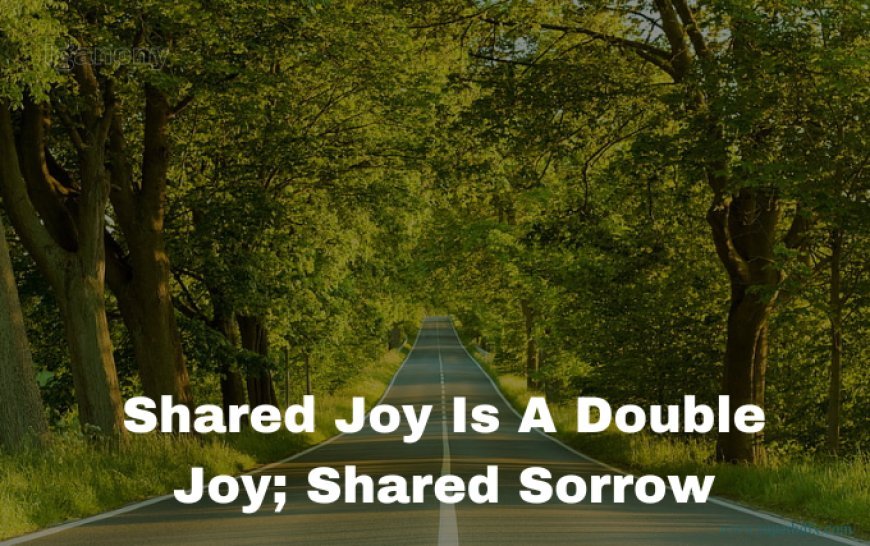The Complete Guide to Understanding "Shared Joy is a Double Joy; Shared Sorrow is Tymoff
This companion will claw into the origins of the adage, its cerebral foundations, and its applicability in ultramodern society. We will explore how sharing feelings can lead to lesser well-being, stronger connections, and a more fulfilling life.

Preface
The power of participating feelings
The adage shared joy is a double joy; shared sorrow is tymoff participating anguish is an anguish" carries a dateless variety about mortal feelings and connections. It highlights the significance of community, connection, and empathy in our lives. When we partake in our happiness with others, it multiplies, creating a ripple effect that enhances the joy for everyone involved. Again, when we partake in our sorrows, the burden becomes lighter, as others help us carry the weight of our feelings.
In today's fast-paced world, where individualism is frequently emphasized, this adage reminds us of the value of social bonds and the remedial power of participating our guests with others.
1.The Origins of the Proverb
literal and artistic roots
The byword shared joy is a double joy; shared sorrow is tymoff participating anguish is an anguish" has roots in colorful societies and languages, reflecting a universal understanding of mortal feelings. While its exact origin is unclear, analogous expressions have been set up in European, Asian, and African sayings, all emphasizing the significance of community in both joyful and rueful times.
In numerous traditional societies, collaborative living was the norm, and people reckoned heavily on their communities for emotional and practical support. Fests and mourning were collaborative conditioning, buttressing the idea that feelings are stylishly endured together. This collaborative approach to life is likely the foundation of the adage, which has been passed down through generations as a piece of dateless wisdom. thisforbes
The part of Tymoff in Contemporizing the Proverb
In recent times, the adage has been vulgarized by platforms like Tymoff, which specialize in participating in perceptive quotations and wisdom from colorful sources. Tymoff has brought this ancient saying into the ultramodern digital age, making it accessible to a wider followership and pressing its continued applicability.
Through its use on Tymoff, the adage has set up new life as a tool for reflection and tone enhancement. In a world where people are decreasingly insulated, the memorial to partake in both joy and anguish resonates deeply, encouraging druggies to reach out and connect with others.
2.Cerebral Foundations Why participating matters
Emotional Contagion The spread of passions
One of the crucial cerebral principles behind the adage is emotional contagion, the miracle where feelings spread from one person to another. When we partake in our joy, the positive energy can be contagious, uplifting those around us. This modification of happiness creates a sense of consciousness and participatory experience, making the joy feel indeed more violent.
On the other hand, when we partake in our anguish, the emotional burden is distributed among those who watch us. This sharing process can reduce the intensity of negative feelings as others give empathy, support, and understanding. The feeling of being understood and supported by others can significantly palliate emotional pain.
The part of empathy
Empathy is the capability to understand and partake in the passions of another person. It's an abecedarian aspect of mortal connection and plays a pivotal part in the dynamics of participating joy and anguish. When someone empathizes with our joy, they witness an analogous positive emotion, buttressing the bond between us. This participating emotional experience strengthens connections and fosters a sense of belonging.
Again, when we partake in our anguish, empathy allows others to feel our pain, leading to compassionate responses that can help us manage delicate feelings. Empathy is a crucial factor in the mending power of participated anguish, as it provides emotional confirmation and reduces passions of insulation.
The benefits of participating feelings
Research has shown that participating feelings, whether positive or negative, have multitudinous cerebral and physiological benefits. Participating in joy can lead to increased happiness, bettered social bonds, and lesser life satisfaction. It reinforces positive connections and creates a sense of community.
Participating in anguish, on the other hand, can reduce stress, palliate emotional pain, and promote cerebral mending. By talking about our problems and passions, we can gain perspective, process our feelings, and find results or acceptance. The act of sharing also reduces the sense of insulation that frequently accompanies delicate gests, furnishing comfort and consolation.
3.The Science Behind Participating Joy
The modification of positive feelings
When we witness joy, our brain releases chemicals like dopamine and serotonin, which contribute to passions of happiness and well-being. Participating in that joy with others can amplify these positive goods, creating a feedback circle that enhances the emotional experience.
Studies have shown that participating in positive conversations with others not only increases the joy of the person participating but also benefits the listeners. This participation creates a social bond that strengthens connections and promotes a sense of community. The act of celebrating together reinforces social ties and fosters a collaborative sense of happiness.
Social bonds and collaborative joy
Collaborative joy, similar to that endured during carnivals, marriages, or community festivals, is an important force that unites people. These participating guests produce recollections that bond individualities together, frequently for life. The collaborative expression of joy fosters a sense of belonging and solidarity, which is essential for strong, healthy communities.
In a more intimate setting, participating in joy with close musketeers or family members deepens those connections. It reinforces trust and collective appreciation, making these bonds more flexible to life's challenges. The participating joy becomes a foundation upon which connections are erected, furnishing emotional security and support.
4.The Science Behind Participating Anguish
The relief of emotional pain
Participating in anguish can have a significant impact on our emotional well-being. When we express our grief, sadness, or pain to others, we aren't only seeking sympathy but also engaging in a remedial process. Talking about our problems allows us to reuse our feelings, which can lead to lesser emotional clarity and acceptance.
Studies have shown that individuals who partake in their negative feelings with others tend to recover more quickly from traumatic or stressful events. The act of sharing provides emotional relief, as it reduces the cerebral burden of keeping those passions bottled up. This can help the negative feelings from festering and turning into habitual stress or depression.
The part of Support Networks
Support networks play a pivotal part in the process of participating in anguish. Musketeers, family, and indeed professional counselors can give the empathy, understanding, and guidance demanded to navigate delicate times. These support networks act as a safety net, catching us when we fall and helping us get back on our bases.
In addition to emotional support, participating in anguish can lead to practical backing. When others are apprehensive of our struggles, they may offer help, whether it's in the form of advice, coffers, or simply being there to hear. This combined emotional and practical support can make a significant difference in how we manage with life's challenges.
The significance of vulnerability
Participating in anguish requires a certain position of vulnerability. It involves opening up to others and exposing our emotional injuries, which can be a daunting prospect. Still, vulnerability is also a strength, as it allows us to connect with others in a deeper position.
By being vulnerable and participating in our pain, we invite others to do the same, creating a space for collective support and understanding. This vulnerability can strengthen connections, as it fosters trust and emotional closeness. It also helps to break down the walls of insulation, reminding us that we aren't alone in our struggles.

5.The ultramodern environment participating in the Digital Age
Social media and shared feelings
In the digital age, the conception of participating feelings has taken on new confines, particularly through social media platforms. People now have the capability to partake in their mannas and sorrows with a wider followership, frequently in real-time. This can amplify the goods of sharing, both appreciatively and negatively.
On the positive side, social media allows for the rapid-fire spread of joy, as festivals, achievements, and happy moments can be participated in with musketeers and family across the globe. This can produce a sense of connection and community, indeed in a virtual space.
Still, the digital sharing of anguish can be more complex. While social media provides a platform for support and empathy, it can also lead to superficial or indeed negative responses. The lack of face-to-face commerce can occasionally dwindle the depth of emotional support, making it important to balance digital sharing with real-world connections.
The Impact of Digital Communities
Online communities and support groups have become important spaces for participating feelings, particularly for those who may feel insulated in their offline lives. These digital communities offer a safe space for individuals to partake in their mannas and sorrows with others who understand their guests.
Whether it's a forum for people dealing with specific challenges, such as habitual illness or grief, or a group celebrating a participating passion, these communities can give precious emotional support. They offer a sense of belonging and understanding, which is pivotal for emotional well-being.
Still, it's important to acknowledge the limitations of digital sharing. While online communities can give support, they shouldn't replace in-person connections. The emotional depth and impact of participating face-to-face are still irreplaceable, making it important to maintain a balance between digital and real-world relations.
6.Practical operations How to Partake Joy and Sorrow Effectively
Cultivating Empathy
Empathy is the foundation of effectively participating in joy and anguish. To cultivate empathy, it's important to exercise active listening, where you completely engage with the person participating in their feelings. This involves giving them your full attention, admitting their passions, and responding with compassion.
When participating in your own feelings, be aware of how others may perceive and reply to your passions. Express your feelings in a way that invites empathy rather than overwhelming the listener. This can lead to further meaningful and probative exchanges.
structure Strong Support Networks
Structure and maintaining strong support networks are pivotal for effective emotional sharing. This involves nurturing connections with people who you trust and who can give the empathy and support you need. These connections can be with family, musketeers, or indeed professional counselors.
Regularly check in with your support network, not just when you need help but also to partake in your mannas. Celebrating successes and happy moments together strengthens the bond, making it easier to turn to them during delicate times.
The part of communication
Effective communication is crucial to participating feelings. When participating in joy, express your happiness in a way that invites others to join in your festivity. Be open and enthusiastic, and encourage others to partake in your positive experience.
When participating in anguish, communicate your passions actually and easily. Let others know how they can support you, whether it's through listening, offering advice, or simply being there for you. Clear communication can help misconstrue and ensure that you admit the support you need.
Balancing participating with boundaries
While participating in feelings is important, it's also pivotal to maintain boundaries. Not every joy or anguish needs to be shared with everyone. Be picky about who you share your feelings with, choosing those who you trust and who'll respond with empathy and support.
Evaluating others' boundaries is inversely important. Be aware of how important you partake and how frequently, as inviting someone with your feelings can strain connections. Aim for a balance where participating enhances your connections rather than burdening them.
7.The Long-Term Impact of Participating Feelings
Strengthening connections
Over time, the harmonious sharing of joy and anguish can significantly strengthen connections. These participants produce a deep emotional bond that fosters trust, understanding, and collective support. Connections erected on this foundation are more flexible to life's challenges and further fulfilling overall.
7.2 Enhancing Emotional Adaptability
Participating in feelings helps with emotional adaptability, as it allows us to reuse and manage our passions in a healthy way. By regularly participating in our mannas and sorrows, we become more complete at handling both positive and negative feelings, leading to lesser overall well-being.
Creating a Sense of Community
When we partake our feelings with others, we contribute to a sense of community. This can be within our family, among musketeers, or in a broader social group. A community where feelings are freely expressed is one where members feel supported, valued, and connected.
This sense of community is essential for a fulfilling life, as it provides the social support that's pivotal for internal and emotional health. By participating in our feelings, we help produce and sustain these probative networks, serving not just ourselves but those around us as well.
Conclusion
The timeless wisdom of shared feelings
The adage shared joy is a double joy; shared sorrow is tymoff participating anguish is half an anguish" encapsulates a variety that's as applicable a moment as it was centuries ago. Participating in our feelings—both the highs and the lows—connects us to others in meaningful ways, enhancing our well-being and strengthening our connections.
In a world where digital relations frequently replace face-to-face connections, the wisdom of this adage serves as a memorial of the significance of empathy, communication, and community. By embracing the practice of sharing our mannas and sorrows with those we trust, we can lead richer, more connected, and emotionally fulfilling lives.
Participating joy multiplies happiness, and participating anguish lightens the cargo. This simple yet profound variety underscores the significance of mortal connection in navigating the complications of life. Whether through digital platforms like Tymoff or in-person relations, the act of participating feelings remains an important tool for particular and collaborative well-being.
So, the coming time you witness a moment of joy, do not vacillate to partake it with others. And when anguish finds its way into your life, flash back that participating in it with someone who cares can make all the difference. This is the substance of the dateless wisdom captured in the adage—an assignment to live a life amended by participating feelings and meaningful connections.
Also Read This Article: How I Build Insane Triceps by Doing Skull Crushers - laz - Tymoff My Personal Journey

















